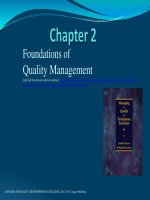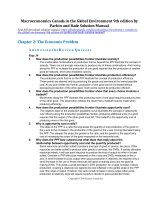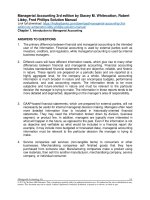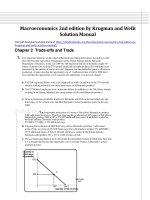Investments 10th edition by bodie kane marcus solution manual
Bạn đang xem bản rút gọn của tài liệu. Xem và tải ngay bản đầy đủ của tài liệu tại đây (232.41 KB, 6 trang )
Chapter 2 - Asset Classes and Financial Instruments
Investments 10th edition by Zvi Bodie, Alex Kane, Alan J.
Marcus Solution Manual
Link full download solution manual: />Link full download test bank: />
CHAPTER 2: ASSET CLASSES AND FINANCIAL
INSTRUMENTS
PROBLEM SETS
1.
Preferred stock is like long-term debt in that it typically promises a fixed payment
each year. In this way, it is a perpetuity. Preferred stock is also like long-term debt
in that it does not give the holder voting rights in the firm.
Preferred stock is like equity in that the firm is under no contractual obligation to
make the preferred stock dividend payments. Failure to make payments does not set
off corporate bankruptcy. With respect to the priority of claims to the assets of the
firm in the event of corporate bankruptcy, preferred stock has a higher priority than
common equity but a lower priority than bonds.
2.
Money market securities are called cash equivalents because of their high level
of liquidity. The prices of money market securities are very stable, and they can
be converted to cash (i.e., sold) on very short notice and with very low
transaction costs. Examples of money market securities include Treasury bills,
commercial paper, and banker's acceptances, each of which is highly marketable
and traded in the secondary market.
3.
(a) A repurchase agreement is an agreement whereby the seller of a security
agrees to “repurchase” it from the buyer on an agreed upon date at an agreed
upon price. Repos are typically used by securities dealers as a means for
obtaining funds to purchase securities.
4.
Spreads between risky commercial paper and risk-free government securities
will widen. Deterioration of the economy increases the likelihood of default
on commercial paper, making them more risky. Investors will demand a
greater premium on all risky debt securities, not just commercial paper.
5.
Corp. Bonds
Voting rights (typically)
contractual obligation
Perpetual payments
Accumulated dividends
Fixed payments (typically)
Payment preference
Preferred Stock
Common Stock
Yes
Yes
Yes
Yes
Second
Yes
Yes
Yes
First
Third
2-1
Copyright © 2014 McGraw-Hill Education. All rights reserved. No reproduction or distribution without the prior written consent of
McGraw-Hill Education.
Chapter 2 - Asset Classes and Financial Instruments
6.
Municipal bond interest is tax-exempt at the federal level and possibly at
the state level as well. When facing higher marginal tax rates, a highincome investor would be more inclined to invest in tax-exempt securities.
7.
a.You would have to pay the ask price of:
161.1875% of par value of $1,000 = $1611.875
8.
b.
The coupon rate is 6.25% implying coupon payments of $62.50 annually or,
more precisely, $31.25 semiannually.
c.
The yield to maturity on a fixed income security is also known as its required
return and is reported by The Wall Street Journal and others in the financial
press as the ask yield. In this case, the yield to maturity is 2.113%. An investor
buying this security today and holding it until it matures will earn an annual
return of 2.113%. Students will learn in a later chapter how to compute both the
price and the yield to maturity with a financial calculator.
Treasury bills are discount securities that mature for $10,000. Therefore, a specific Tbill price is simply the maturity value divided by one plus the semi-annual return:
P = $10,000/1.02 = $9,803.92
9.
The total before-tax income is $4. After the 70% exclusion for preferred stock
dividends, the taxable income is: 0.30 $4 = $1.20
Therefore, taxes are: 0.30 $1.20 = $0.36
After-tax income is: $4.00 – $0.36 = $3.64
Rate of return is: $3.64/$40.00 = 9.10%
10.
a.You could buy: $5,000/$64.69 = 77.29 shares. Since it is not possible to trade in
fractions of shares, you could buy 77 shares of GD.
b.
Your annual dividend income would be: 77 $2.04 = $157.08
c.
The price-to-earnings ratio is 9.31 and the price is $64.69. Therefore:
$64.69/Earnings per share = 9.3 Earnings per share = $6.96
d.
General Dynamics closed today at $64.69, which was $0.65 higher than
yesterday’s price of $64.04
2-2
Copyright © 2014 McGraw-Hill Education. All rights reserved. No reproduction or distribution without the prior written consent of
McGraw-Hill Education.
Chapter 2 - Asset Classes and Financial Instruments
11.
a.At t = 0, the value of the index is: (90 + 50 + 100)/3 = 80
At t = 1, the value of the index is: (95 + 45 + 110)/3 = 83.333
The rate of return is: (83.333/80)
b.
1 = 4.17%
In the absence of a split, Stock C would sell for 110, so the value of
the index would be: 250/3 = 83.333 with a divisor of 3.
After the split, stock C sells for 55. Therefore, we need to find the divisor
(d) such that: 83.333 = (95 + 45 + 55)/d d = 2.340. The divisor fell,
which is always the case after one of the firms in an index splits its
shares.
c.
12.
The return is zero. The index remains unchanged because the return
for each stock separately equals zero.
a.Total market value at t = 0 is: ($9,000 + $10,000 + $20,000) = $39,000
Total market value at t = 1 is: ($9,500 + $9,000 + $22,000) = $40,500
Rate of return = ($40,500/$39,000) – 1 = 3.85%
b.
The return on each stock is as follows:
rA = (95/90) – 1 = 0.0556
rB = (45/50) – 1 = –0.10
rC = (110/100) – 1 = 0.10
The equally weighted average is:
[0.0556 + (-0.10) + 0.10]/3 = 0.0185 = 1.85%
13.
The after-tax yield on the corporate bonds is: 0.09 (1 – 0.30) = 0.063 = 6.30%
Therefore, municipals must offer a yield to maturity of at least 6.30%.
14.
Equation (2.2) shows that the equivalent taxable yield is: r = rm /(1 – t), so
simply substitute each tax rate in the denominator to obtain the following:
a.
4.00%
b.
4.44%
c.
5.00%
d.
5.71%
2-3
Copyright © 2014 McGraw-Hill Education. All rights reserved. No reproduction or distribution without the prior written consent of
McGraw-Hill Education.
Chapter 2 - Asset Classes and Financial Instruments
15.
In an equally weighted index fund, each stock is given equal weight regardless of its
market capitalization. Smaller cap stocks will have the same weight as larger cap
stocks. The challenges are as follows:
Given equal weights placed to smaller cap and larger cap, equalweighted indices (EWI) will tend to be more volatile than their
market-capitalization counterparts;
It follows that EWIs are not good reflectors of the broad market that they
represent; EWIs underplay the economic importance of larger
companies.
Turnover rates will tend to be higher, as an EWI must be rebalanced
back to its original target. By design, many of the transactions would
be among the smaller, less-liquid stocks.
16.
a.The ten-year Treasury bond with the higher coupon rate will sell for a higher price
because its bondholder receives higher interest payments.
17.
b.
The call option with the lower exercise price has more value than one with a
higher exercise price.
c.
The put option written on the lower priced stock has more value than one
written on a higher priced stock.
a.You bought the contract when the futures price was $7.8325 (see Figure
2.11 and remember that the number to the right of the apostrophe represents an
eighth of a cent). The contract closes at a price of $7.8725, which is $0.04 more
than the original futures price. The contract multiplier is 5000. Therefore, the
gain will be: $0.04 5000 = $200.00
b.
18.
Open interest is 135,778 contracts.
a.Owning the call option gives you the right, but not the obligation, to buy at
$180, while the stock is trading in the secondary market at $193. Since the
stock price exceeds the exercise price, you exercise the call.
The payoff on the option will be: $193 - $180 = $13
The cost was originally $12.58, so the profit is: $13 - $12.58 = $0.42
b.
Since the stock price is greater than the exercise price, you will exercise the
call. The payoff on the option will be: $193 - $185 = $8
The option originally cost $9.75, so the profit is $8 - $9.75 = -$1.75
c.
Owning the put option gives you the right, but not the obligation, to sell at $185,
but you could sell in the secondary market for $193, so there is no value in
2-4
Copyright © 2014 McGraw-Hill Education. All rights reserved. No reproduction or distribution without the prior written consent of
McGraw-Hill Education.
Chapter 2 - Asset Classes and Financial Instruments
exercising the option. Since the stock price is greater than the exercise
price, you will not exercise the put. The loss on the put will be the initial
cost of $12.01.
19.
There is always a possibility that the option will be in-the-money at some time prior to
expiration. Investors will pay something for this possibility of a positive payoff.
20.
a.
b.
c.
d.
e.
a.
b.
c.
d.
e.
Value of Call at Expiration Initial Cost
0
4
0
4
0
4
5
4
10
4
Value of Put at Expiration Initial Cost
10
6
5
6
0
6
0
6
0
6
Profit
-4
-4
-4
1
6
Profit
4
-1
-6
-6
-6
21.
A put option conveys the right to sell the underlying asset at the exercise price. A
short position in a futures contract carries an obligation to sell the underlying asset
at the futures price. Both positions, however, benefit if the price of the underlying
asset falls.
22.
A call option conveys the right to buy the underlying asset at the exercise price. A
long position in a futures contract carries an obligation to buy the underlying asset
at the futures price. Both positions, however, benefit if the price of the underlying
asset rises.
CFA PROBLEMS
1.
(d) There are tax advantages for corporations that own preferred shares.
2.
The equivalent taxable yield is: 6.75%/(1 0.34) = 10.23%
3.
(a) Writing a call entails unlimited potential losses as the stock price rises.
2-5
Copyright © 2014 McGraw-Hill Education. All rights reserved. No reproduction or distribution without the prior written consent of
McGraw-Hill Education.
Chapter 2 - Asset Classes and Financial Instruments
4.
a.The taxable bond. With a zero tax bracket, the after-tax yield for the taxable
bond is the same as the before-tax yield (5%), which is greater than the
yield on the municipal bond.
b.
The taxable bond. The after-tax yield for the taxable bond is:
0.05(1 – 0.10) = 4.5%
c.
You are indifferent. The after-tax yield for the taxable bond is:
0.05 (1 – 0.20) = 4.0%
The after-tax yield is the same as that of the municipal bond.
d.
5.
The municipal bond offers the higher after-tax yield for investors in tax
brackets above 20%.
If the after-tax yields are equal, then: 0.056 = 0.08 × (1 –
t) This implies that t = 0.30 =30%.
2-6
Copyright © 2014 McGraw-Hill Education. All rights reserved. No reproduction or distribution without the prior written consent of
McGraw-Hill Education.









